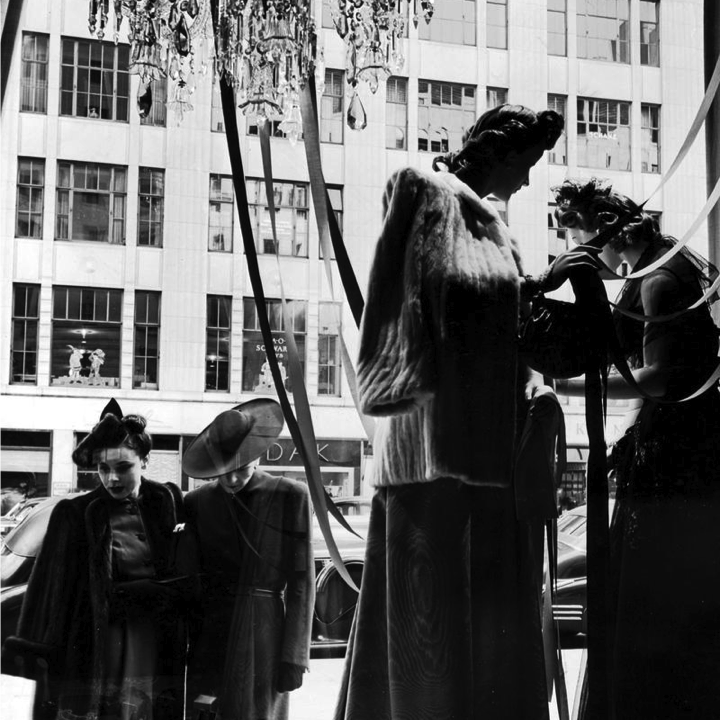Year One Research
Year One Research: 2013

The first year of Women in New York Fashion: A Research Agenda (WNYF) presented researchers with what seemed at first to be a meticulous, yet straightforward task. The project’s timeline laid out the goals for the initial phase (January 2013 – February 2014): focus on the evolution of fashion retail in New York City, and begin research on Geraldine Stutz. 2013 Stutz fellows Maureen Brewster and Junyao Peng set out to survey the landscape of New York fashion retail, past and present.
The initial bibliography was comprised primarily of books about the development of New York City as a cultural center and fashion producer, as well as the role of women within those contexts. The fellows evaluated each text and then wrote a short notation for each entry on the bibliography, which detailed the text’s content and relevance to the project. By mining the bibliographies of each text on that initial list, the research gradually expanded to cover a broader array of sources, from web articles to historic district reports.
Initial research showed that within the history of each store, and in the broader network of stores, there were many moments in which the store’s history had a direct connection to the evolution of the city and the advancement of women. To study this evolution of individual stores and their network within NYC, the fellows compiled timelines for each store, along with a master department store timeline highlighting industry growth and achievements. The timelines were a great way to gain a clearer picture of when and how department stores formed and merged, key figures and places, and relationships between the development of stores and the development of the city. In doing so, the Fellows found that there are a lot of intersections among department stores, such as mergers, acquisitions, and the like. Many key figures owned several stores or were connected in various ways to multiple chains (the Gimbels being a notable example). The timelines also showed, however, that there were some inconsistencies between published dates for various milestones of many stores; it was also difficult to find any information for smaller stores that did not survive the earliest years (such as Constable and Co.), or to find unbiased information published about the larger stores (many, such as Macy’s, have published books about their own histories).
As the project grew, however, several more issues began to arise. The first, and most obvious, was that academic texts alone would not suffice as a viable source to consider this history. Research was broadened to include museum databases and collections, starting with the Museum of the City of New York (housing a spectacular, searchable photography collection), the Metropolitan Museum of Art, The Museum at FIT (holding midcentury Lord and Taylor advertisements, among other treats), and the Smithsonian Institute (houses the Dorothy Shaver papers, chronicling another famous woman fashion executive). With this search underway, the fellows then began to research archives that would be able to contribute to the project. While the FIT archives were very helpful, it soon became apparent that access to department store archives would be much trickier. The fellows contacted Bloomingdales, Barneys, Bergdorf Goodman, Saks Fifth Avenue, Macy’s, Lord and Taylor, and Henri Bendel – out of these, Macy’s is the only store with an official, functioning archive. Some others may have archival space through the family associated with the creation of the store, but ultimately was undetermined.
This unexpected hole in primary sources was surprising, and ended up becoming a recurring issue in the first year of research. Though there was a diverse array of sources chronicling the early years of the retail industry in New York City, and even a decent selection of sources detailing the experiences of women within it, there were far fewer sources charting the industry into the late twentieth century. Those that did were often published by the department stores themselves, raising questions about their potential bias and authenticity. Most glaringly absent were sources documenting the rise of female fashion executives, apart from the few profiles of Dorothy Shaver or other higher-profile women (and even these tended to be either frustratingly brief or confined to publicity puff pieces). Most sources discussing women in the fashion industry were centered on their role as lower-level employees, whether in shops or in clothing manufacture. Meanwhile, sources on Geraldine Stutz herself were almost completely nonexistent, apart from lucky finds such as an FIT archive video.
These concerns became paramount during the project’s transition from the first to second year, and highlighted the changes in methodology that would be required to make greater strides in documenting this underexplored history of the retail industry. The first year of the WNYF project thus presented some unique challenges to the 2013 fellows. Without a comprehensive source for general history of the department store over the course of their history (many focus on individual stores and individual periods of their history) it became clear that a variety of methodologies would be required to fill in the gaps in historical documentation of the role of women within those spaces. The second issue was of provenance: notably, an overall lack of academic sources, particularly in relation to the role of women in executive roles within the 20th century department store. The project also pointed to how under-researched this particular area of the retail industry is, despite a growing number of women leading the retail industry over the course of the twentieth century. Last but not least are the problems with historical perspective: later sources in particular are more focused on marketing and merchandising issues in the retail industry, and there are few that provide an unbiased examination of their evolution. By addressing these critical issues, the second year of Women in New York Fashion: A Research Agenda promises to yield much more productive research on this important part of New York City retail (and women’s) history.